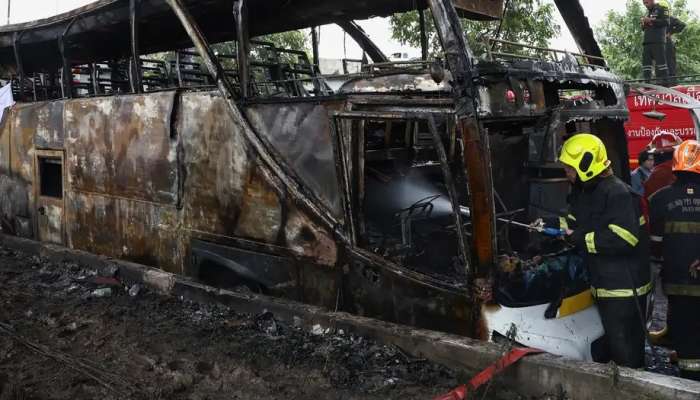
Bangkok: Road safety in Thailand has been thrust into the public spotlight following a deadly incident last week when a school bus caught fire and killed 23 young students and teachers.
Investigations are ongoing to determine what ignited the blaze, but it was suggested a gas leak may have caused it. Authorities found out that the bus was fitted with 11 natural gas canisters even though it had a permit for only six.
Public outrage has put officials under scrutiny regarding safety standards, especially after it emerged that the bus had passed an inspection only four months before the fire.
Families of the victims have called for a tightening of vehicle safety.
CNG buses and fire safety standards
Thai Transport Minister Suriya Jungrungreangkit said the government would launch a probe into the use of compressed natural gas (CNG) in buses.
According to official data, there are over 13,000 CNG-powered buses in the country.
The Transport Ministry has ordered the Department of Land Transport (DLT) to inspect all CNG buses within two months to ensure that they meet fire safety standards.
Sumet Ongkittikul, research director for transportation and logistics policy at the Thailand Development Research Institute, told broadcaster Thai PBS that many buses that are in service do not meet the standards.
He pointed out that only 5% of the around 10,000 buses meet the new standards on non-flammable materials that came into effect in 2022.
However, the new regulations did not apply to the vehicles that had already been in service, and bus firms complained that fitting their old vehicles with fire-retardant materials would be too costly, Sumet said.
"In other countries, similar standards are applied retroactively to both old and new buses," he underlined.
Dangerous roads
Thai journalist Pravit Rojanaphruk said road safety has long been a major issue in Thailand, with inadequate enforcement contributing to thousands of deaths annually.
The Southeast Asian country has one of the highest rates of traffic fatalities in the world, recording about 25.7 deaths per 100,000 people in 2021, compared with a global average of 15, according to the World Health Organization (WHO).
In Asia, Thailand has the second-deadliest roads after Nepal. It ranks 16th in the world for traffic mortality, alongside Chad and Guinea-Bissau, the WHO said.
Overall, around 20,000 people are killed every year on Thailand's roads — an average of more than 50 a day.
"There has been very little or no tangible improvement. Most pillion riders on a motorcycle continue to travel not wearing a helmet. Bus inspection is susceptible to bribery and we only talk about road safety when there are major traffic accidents like the school bus fire which killed 23," Pravit told DW.
"The situation is made more tragic by the lack of will from politicians, officials and the general public to make tangible improvement on road safety a national agenda with clearly a set target to reduce the average 38 people killed on the road every single day since January 1 this year," he added.
What's the situation in other SEA countries?
The problem is, however, not limited to Thailand, as other Southeast Asian nations, particularly Malaysia and Vietnam, confront similar challenges.
In September, Malaysian Transport Minister Anthony Loke said there was an urgent need to address road safety issues in the country after statistics showed there were 6,443 fatalities in 2023.
He called for the daily publication of fatal crash statistics in efforts to raise awareness among drivers and encourage them to take more precautions.
He also urged drivers to join local commuting safety programs and aims to reduce road deaths by half by the year 2030.
The type of transport also plays a major role in the accidents.
In Thailand, for instance, over 4 in 5 deaths involved motorbikes, compared with a global average of 1 in 5, the AFP news agency reported, citing road safety watchdog Thai RSC.
Motorcycles and moped scooters are also ubiquitous on Vietnam's streets. And it is estimated that motorcycle-related incidents account for about 80% of total road traffic crashes in the country. .
The Vietnamese government came up with new rules this year to tackle road safety issues, for instance, mandating all children traveling in vehicles to be secured in a child car seat if they are aged under 10 or below 135 cm (around 4' 4") in height.
The WHO said road traffic crashes are a leading cause of death for children and young adults aged 5 to 29 years, in Vietnam as well as globally.
With the new safety rules, the road-related deaths of Vietnamese children could come down by up to 71%, the agency estimated.
"These law changes are a vote for children's safety, and will help realise the promise of safe mobility — especially for young people — in Vietnam," Angela Pratt, WHO representative in Vietnam, said in July.
Experts and entrepreneurs in Southeast Asia have called for countries to create real-time apps to monitor road conditions and provide updates to drivers on the road.
Some politicians have spoken in favor of adopting latest technologies and artificial intelligence tools to tackle traffic problems.
Thai Transport Minister Suriya suggested the use of Chinese technology to prevent road accidents.
"If Huawei's technology can boost the efficiency of traffic management and disaster prevention, it will be a good opportunity to promote Thailand as a regional transport hub in line with the government's policy," he said in September.